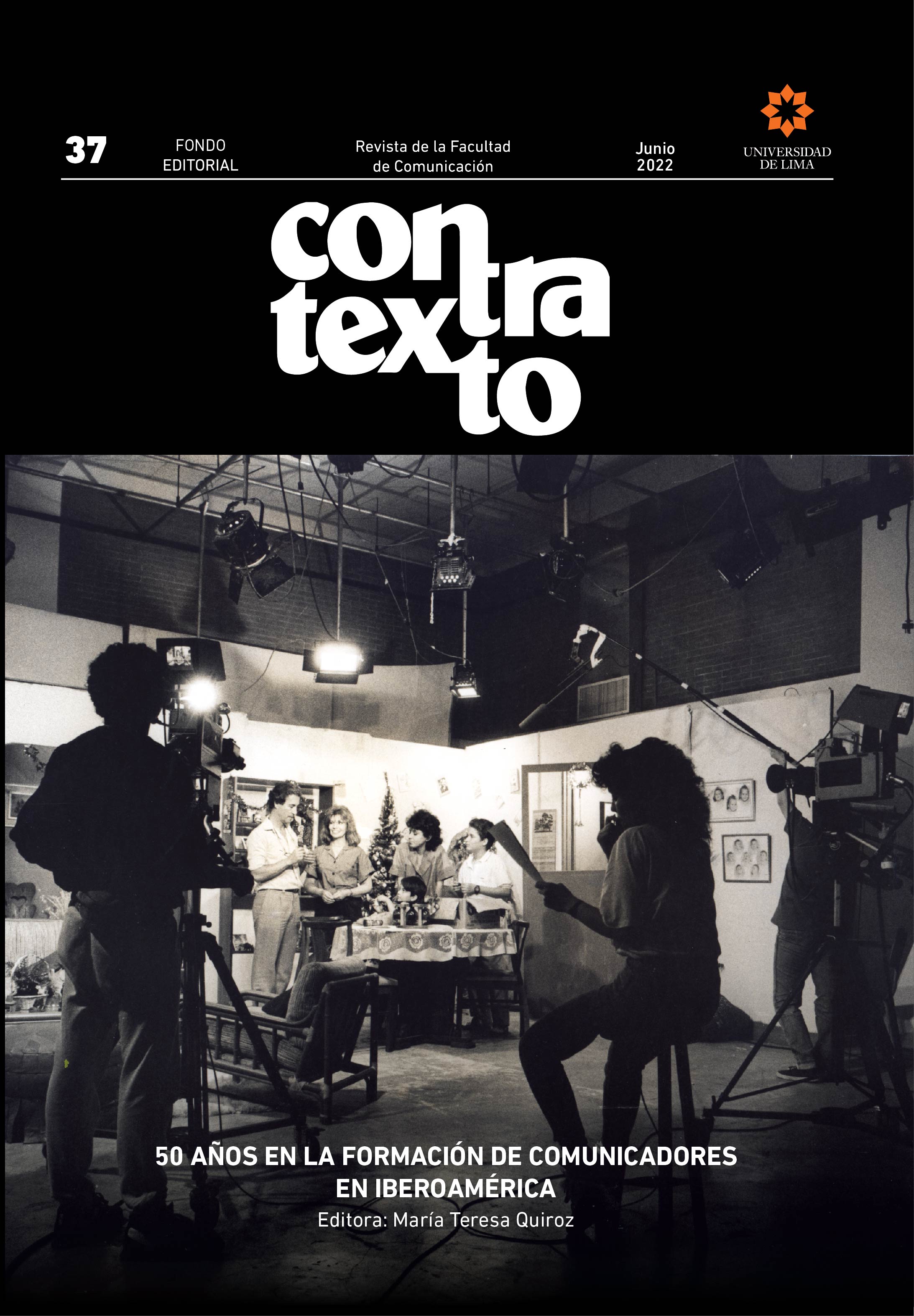The Representation of Youtubers and Instagrammers In International Audiovisual Production
DOI:
https://doi.org/10.26439/contratexto2022.n037.5244Keywords:
cinema, Instagram, YouTube, media education, valuesAbstract
The article analyses the inclusion of YouTubers and Instagrammers in international audiovisual production. It shows the progressive introduction of these figures in popular consciousness through the cultural map drawn by current film productions. A quantitative and qualitative content analysis was carried out on 1738 audiovisual productions that included the terms YouTuber or Instagrammer in the title or as a keyword. We accessed all the stories with these figures as subjects through IMDb to find out the number of productions, the progressive growth and the different audiovisual genres which portray them. Through an analysis of keywords, synopses and specialized reviews, it has been possible to determine the features of these new communicators as reflected by fiction films. The results show the weight of the negative characteristics in their personalities and performances, the absence of values and the risks derived from irresponsible use of the networks. Due to the capacity of cinema to question and educate, the conclusion is the need for ethical and aesthetic training by filmmakers and citizens consuming audiovisual media.
Downloads
References
Almeida, R. (2017). Influencers. La nueva tendencia del marketing online. Editorial Base.
Alonso Escontrela, M. L., & Pereira Domínguez, M. C. (2000). El cine como medio-recurso para la educación en valores: un enfoque teórico y tecnológico. Pedagogía Social, 5, 127-147. http://e-spacio.uned.es/fez/eserv/bibliuned:revistaPS-2000-05-2070/Documento.pdf
Aumont, J. (2016). Estética cinematográfica. Papirus.
Baca, J. A. (2004). Cine y ficción social. En J. A. Baca & A. Galindo (Eds.), Cine y prospectiva social (pp. 101-124). Diputación de Almería.
Baca, J. A., & Galindo, A. (2004). Cine y prospectiva social. Diputación de Almería.
Berlanga, I., & Fernández, L. (2020). Cine y youtubers: nuevas audiencias, nuevas experiencias. Tsafiqui. Revista Científica en Ciencias Sociales, 11(15), 45-56. https:// 10.29019/tsafiqui.v11i15.806
Berlanga, I., Velásquez, A., & Sánchez, M. (2019). Entre youtubers, influencers y brand ambassadors: exposición de la marca en formatos sociales. Realidad y ficción. En L. M. Romero & D. Rivera (Coords.), La comunicación en el escenario digital: actualidad, retos y prospectivas (pp. 473-502). Pearson.
Bonaga, C., & Turiel, H. (2016). Mamá, ¡quiero ser youtuber!: todas las claves para entender el fenómeno que ha venido para quedarse. Temas de Hoy.
Castell-Martínez, A. (2016). El marketing de influencia: un caso práctico. En I. Zacipa, V. Tur-Viñes & J. Segarra-Saavedra (Coords.), Tendencias publicitarias en Iberoamérica: diálogo de saberes y experiencias (pp. 49-65). Universidad de Alicante. http://dx.doi.org/10.14198/MEDCOM/2016/8
Ekinci, B. T. (2020). Youtuber movies from new media to the cinema. CINEJ Cinema Journal, 8(2), 94-118. http://dx.doi.org/10.5195/cinej.2020.230
Esqueda-Verano, L. (2019). El cine como espejo diferido: el concepto de transferencia en André Bazin y Stanley Cavell. Palabra Clave, 22(3), 1-27. https://doi.org/10.5294/pacla.2019.22.3.4
Gervilla Castillo, E. (2004). Buscando valores. El análisis de contenido axiológico. Perfiles Educativos, 26(103), 95-110. http://www.scielo.org.mx/scielo.php?pid=S0185-26982004000200006&script=sci_arttext
González-Carrión, E. L., & Aguaded, I. (2020). Engagement y evolución de instagramers hispanohablantes de moda. Revista Latina, 77, 231-252. https://doi.org/10.4185/RLCS-2020-1456
Hassan-Montero, Y., Herrero-Solana, V., & Guerrero-Bote, V. P. (2010). Usabilidad de los tag-clouds: estudio mediante eye-tracking. Scire, 16(1), 15-33. http://hdl.handle.net/10481/41569
Herr, B. W., Ke, W., Hardy, E., & Börner, K. (2007). Movies and actors: mapping the Internet Movie Database. En Conference Proceedings of 11th Annual Information Visualization International Conference (IV 2007) (pp. 465-469). IEEE Computer Society Conference Publishing Services.
Jaramillo-Dent, D., Vizcaíno-Verdú, A., De-Casas-Moreno, P., & Baldallo-González, C. (2020). Instagramming. Temas, tópicos y tendencias. Octaedro.
Jenkins, H. (2008). Convergence Culture. La cultura de la convergencia de los medios de comunicación. Paidós.
Fernández-Cruz, F. J., & Fernández-Díaz, M. J. (2016). Los docentes de la generación Z y sus competencias digitales. Comunicar, 24(46), 97-105. https://10.3916/C46-2016-10
Hidalgo-Marí, T., & Segarra-Saavedra, J. (2017). El fenómeno youtuber y su expansión transmedia. Análisis del empoderamiento juvenil en redes sociales. Fonseca, Journal of Communication, 15, 43-56. http://dx.doi.org/10.14201/fjc2017154356
Imbert, G. (2010). Cine e imaginarios sociales. El cine posmoderno como experiencia de los límites. Cátedra.
Kracauer, S. (2006). Estética sin territorio. Colegio Oficial de Aparejadores y Arquitectos Técnicos de la Región de Murcia.
Marfil, R., & Repiso, R. (2011). IMDb y su utilidad para la investigación cinematográfica: ejemplos de uso de datos desde la metodología de análisis de redes sociales. En I. Bort, S. García & M. Martín (Eds.), Actas IV Congreso Internacional sobre Análisis Fílmico, Nuevas Tendencias e Hibridaciones de los Discursos Audiovisuales en la Cultura Digital Contemporánea (pp. 1207-1219). Ediciones de las Ciencias Sociales.
Monserrat-Gauchi, J., & Sabater-Quinto, F. (2017). Planificación estratégica de la comunicación en redes sociales. UOC.
Morin, E. (1961). El cine o el hombre imaginario. Seix Barral.
Osman, M. (2021, 8 de junio). Estadísticas y datos impresionantes del YouTube (el segundo sitio más visitado). Kinsta. https://kinsta.com/es/blog/estadisticas-youtube/
Pérez-Martínez, A., & Acosta-Díaz, H. (2003). La convergencia mediática: un nuevo escenario para la gestión de información. ACIMED, 11(5). http://scielo.sld.cu/scielo.php?script=sci_arttext&pid=S1024-94352003000500003&lng=es&tlng=es
Rojas, B. (2010). Investigación cualitativa. Fundamentos y praxis. Universidad Pedagógica Experimental Libertador, Fondo Editorial.
Scolari, C. A., & Fraticelli, D. (2019). The case of the top Spanish YouTubers: Emerging media subjects and discourse practices in the new media ecology. Convergence, 25(3), 496-515. https://doi.org/10.1177/1354856517721807
Sorlin, P. (1985). Sociología del cine. La apertura para la historia del mañana. Fondo de Cultura Económica.
Zabaleta, M. R., & Rojas, T. P. (2021). El escenario de la convergencia mediática desde la Ecología de los Medios: transformaciones y retos para el sistema de medios de comunicación con miras al modelo digital de gestión de contenidos. Revista Compás Empresarial, 10(31), 94-124. https://doi.org/10.52428/20758960.v10i31.81
Downloads
Published
Issue
Section
License
All of the works published are licensed under a CC BY 4.0 Creative Commons Attribution license. (updated on March 1st 2021)
The content of the journal may be shared in any material or format. The content may be adapted, contributed upon and transformed. Both possibilities are only permitted in so far as they complete the following conditions:
- Attribution: Credit must be given where it is due, a link to the license must be provided and changes, if made, must be indicated. This should be done in the manner deemed appropriate, without suggesting that the licensor promotes you or your use of the material.
Ownership rights
The patrimonial rights for Contratexto are published under a Creative Commons BY 4.0 license, allowing authors to keep the patrimonial rights to their work without restrictions.
If a work published in Contratexto were to be copied, distributed, spread, or any other activities contemplated in the aforementioned license, the author(s) and the journal must be mentioned visibly and expressly.
Self-archive
This journal allows and encourages authors to post items submitted to the journal on personal websites or institutional repositories both prior to and after publication, while providing bibliographic details that credit, if applicable, its publication in this journal.

















